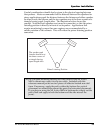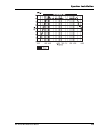
Speaker Installation
M1 Active Mk2 Reference Manual 23
PLAYBACK CHECK MODE (VERTICAL MID-FIELD)
After you’ve got your mix just right it’s always good practice to perform a
“playback check” by standing the M1 Active Mk2s vertically and making the
listening triangle larger. The purpose of the playback check is to simulate
what your masterpiece will sound like in a “typical” home listening
environment. It is in this configuration that the imaging specificity of your
mix can best be evaluated. Generally, in the playback check mode you want
to arrange the speakers in the same equilateral listening triangle that you do
in a nearfield setup, but instead of each side of the triangle being about 3 feet
long, the distances between stereo speakers and to your listening position
should be between 7 and 12 feet.
When setting the left and right speakers vertically, place the tweeters toward
the center with the ports toward the outside. In this vertical position, the M1
Active Mk2 becomes a “line source” speaker which is the most common
home set up. (A 12” three-way with woofer on bottom, midrange in the
center and tweeter at the top is a line source, as are most forms of tower
speakers.) When the M1 Active Mk2 is set vertically in its “column”
configuration, the horizontal dispersion (left and right) of the speaker is
widest, and the vertical dispersion (up and down) is narrowest.
Unfortunately a vertical setup will also increase room effects, so there are
minimum recommended setup distances from side and back walls: the
speakers should be a minimum of 2.5 feet from the side walls and 3 feet from
the rear walls. See the illustration on page 26.
After you’ve got the requisite distances from the side and back walls, it’s
often helpful to adjust the 7 to 12 foot equilateral listening triangle distances.
What you want to find is the maximum distance that you can separate the
two speakers while still holding a solid center image. If you get this
placement correct and you’ve done a good job in the mix, you should be
rewarded with a soundstage that accurately places the musicians in the width
and depth perspective in which they were recorded. The sound should be
very similar to what you heard at your mixing board, with possibly a little
more ambience contributed by the listening room.
The “other” playback check mode, sometimes considered of greater
importance than the home environment, is to listen to your mix over a car
audio system. Bear in mind that an expertly designed car audio system can
approach the imaging and soundstaging capabilities of an optimally setup
studio or living room, but most times this is NOT the case. The inherent
limitations of an always-off-axis listening position and the variables of
speaker placement, bass coupling (boost) in the small interior and numerous
other factors make the car environment highly suspect. So, understand the
sonic capabilities (and deficiencies) of your (or other) car audio systems, and
evaluate your mix accordingly.


















